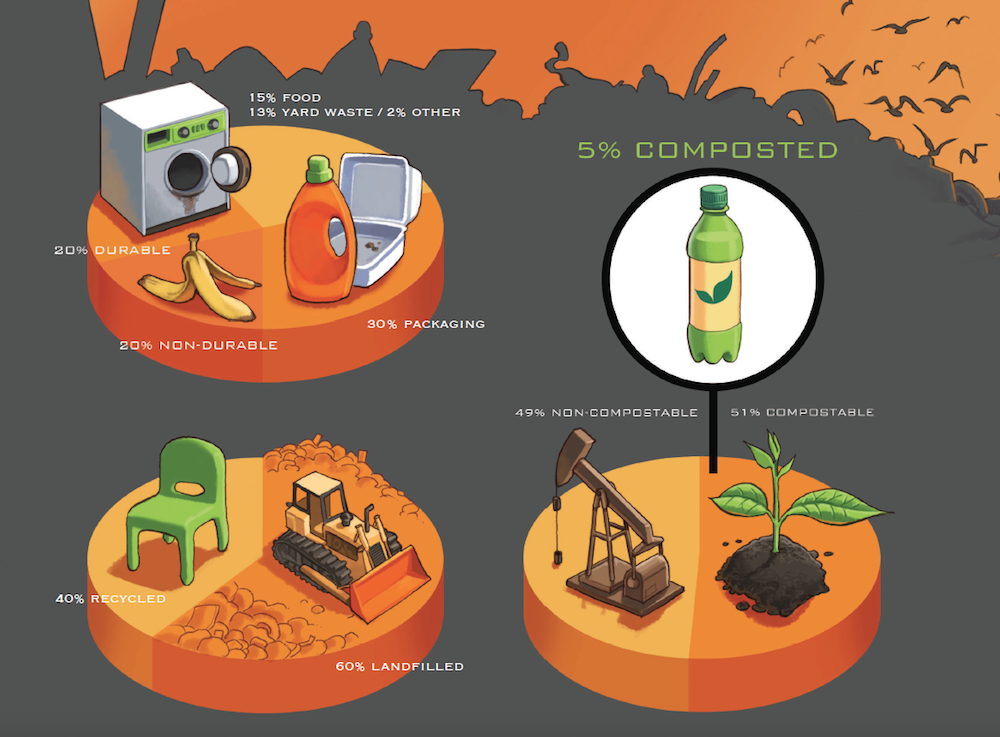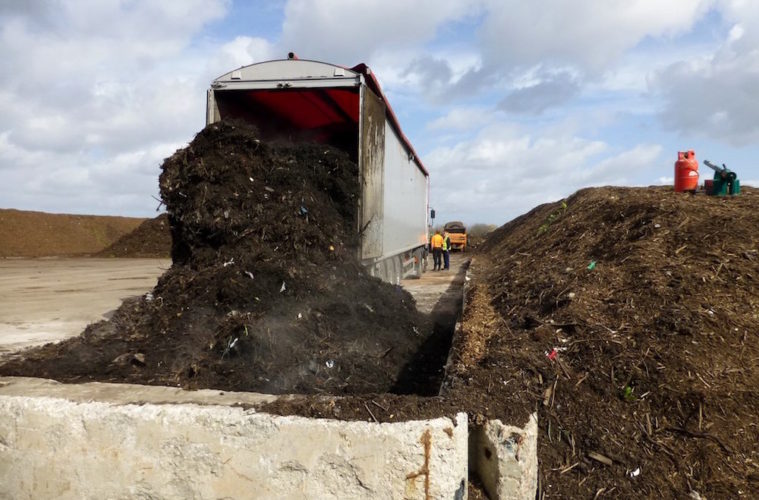In order for hemp bioplastics to be a truly sustainable alternative, they must be compostable — and we must have places to compost them.
Originally published in Issue 4 of HEMP. Subscribe HERE or find in a local grocery store.
Every year, public excitement about the potential of using industrial hemp to make sustainable packaging materials seems to increase. And for good reason — the potential is huge, especially for hemp paperboards and hemp bioplastics.
Hemp has a myriad of present and potential benefits as a feedstock for paperboards and bioplastics. Hemp requires less water than other industrial crops and none of the pesticides, it grows to maturity in just four months and remediates the soil so it’s an ideal rotational crop, one metric ton of hemp sequesters 1.5 metric tons of carbon… and so on and so forth.
But the sustainability of hemp only gets us so far. One of the biggest challenges facing hemp as a feedstock for packaging materials is recovering the materials at the end of their product lifecycles. That said, recovery is a challenge for all packaging materials — whether they’re fossil fuel-based, bio-based, recyclable, biodegradable, or compostable.
A 2016 study by the EPA reveals that 30 percent of our municipal solid waste is packaging. For reference, the next largest categories are durable goods and nondurable goods, both at 20 percent. Furthermore, only 40 percent of packaging waste is recovered while 60 percent is landfilled.

Illustration Daniel Garcia for HEMP (SOURCE: EPA’s 2016 Advancing Sustainable Materials Management Report & The Sustainable Packaging Coalition)
Not only is this an incredible amount of waste, it’s also billions of dollars in lost profits in the form of unrecovered materials. And the problem is even worse when we single out plastic packaging; 95 percent of the value of plastic packaging material is lost after its first-use cycle. That’s the equivalent of $80–$120 billion per year.
There are plenty of incentives to improve our waste recovery systems, both financial and environmental. So, what’s the holdup? And, what’s the solution? It’s a complicated problem, but one that may be solved as we continue to move towards a circular economy.
Building a Circular Hemp Economy
The Ellen MacArthur Foundation, an environmentally focused British think tank, defines a circular economy as “restorative and regenerative by design.” A circular economy is meant to build economic, natural, and social capital by adhering to three guiding principles: design out waste and pollution, keep products and materials in use, and regenerate natural systems.
The philosophical foundations of a circular economy can be traced back thousands of years, as humans learned to follow natural cycles and feedback loops. However, our contemporary concept of a circular economy emerged in the 1970s, when it was becoming clear that our linear “take-make-dispose”industrial model is leading to scarcity, volatility, and unaffordable pricing levels.
What do hemp and hemp-based materials have to do with a circular economy? The short answer is: everything. After all, hemp is both restorative and regenerative. In a circular economy, hemp is an ideal industrial crop and materials feedstock — packaging or otherwise.
The lifecycle of all products is ultimately the same in a circular economy: sourcing, manufacturing, distribution, use, and recovery. Recovery is a challenge, and while it’s just one piece of the puzzle, it’s the most important piece we have to deal with when it comes to packaging. And recovery is further complicated because it includes recycling, composting, and all other waste management strategies.
The Importance of Composting in a Circular Economy
When it comes to bioplastics such as hemp plastic, much of the conversation frequenstly revolves around how easy it is to recycle hemp plastics. However, recycling is not necessarily the simplest option.
Issues with recycling include consumer engagement, access, sorting, processing, and end markets. Consumer engagement is high and people want to recycle. Unfortunately, recycling is difficult and the numbers tell a different story: less than 10 percent of plastic is actually recycled, according to a 2017 report from Science Advances.
Access to recycling in the U.S. varies state-by-state, county-by-county, and city-by-city. When it comes to sorting, material recovery facilities have to separate 2D packaging from 3D packaging. They then have to separate packaging by material type. However, the largest issue with sorting is contamination. For instance, when something like food residue degrades the value of a recoverable material, it can make it difficult and even impossible to recycle.
Concerning the processing of recyclable materials, things like labels, inks, additives, colorants, coatings, etc. can further complicate the process. And even if materials are successfully processed, we have to ensure there’s an end market for the recycled materials.
Recycling isn’t a complete failure, but there’s a gross misconception about the impact and success of the system.
Recycling isn’t a complete failure, but there’s a gross misconception about the impact and success of the system. While we should absolutely recycle everything we can, we can’t view recycling as the ultimate solution to waste recovery; it’s just one piece of the puzzle.
Composting is the other major piece of the waste recovery puzzle. While consumer engagement around composting is much lower than it is around recycling, it has grown significantly in recent years and it will continue to grow as composting becomes a more widely adopted waste recovery strategy.
However, our current infrastructure around composting is lacking. For instance, 51 percent of municipal solid waste in the U.S. is compostable, but we’re currently only able to compost 5 percent of that waste, according to the Sustainable Packaging Coalition.
There’s also public confusion surrounding the terms “biodegradable” and “compostable.” Biodegradable refers to a material’s ability to break down quickly through natural processes into raw materials. Compostable, however, refers to a material’s ability to biodegrade quickly in a composting environment and produce usable compost soil at the end.
Other issues with composting include collection, infrastructure, processing, and certifications. There are three general types of composting: home composting, community composting, and commercial composting. Further complicating the issue, not all composting facilities are created equal and the variance in access and processing capabilities varies even more than with recycling.
Less than 5 percent of composting facilities in the U.S. accept even the most basic compostable packaging materials.
However, this doesn’t change the fact that compostable packaging will play a huge role in the future of composting. Certifications will be the key to the success of compostable packaging because they will help bridge the current gap between compostable materials and composters.
With that in mind, an interesting opportunity is emerging in the U.S. due to the growing number of biomass energy plants coming online. Wood chips — a key ingredient for composters — are now less available because they’re being redirected to biomass energy plants. This opens the door for compostable packaging to become more widely accepted by composters. Furthermore, composters with volume-based pricing stand to make a lot of profit by accepting compostable packaging.
Ultimately, we need to move away from fossil fuel-based packaging materials and continue developing more bio-based packaging materials.
Ultimately, we need to move away from fossil fuel-based packaging materials and continue developing more bio-based packaging materials. These are all relatively new technologies and they’re not perfect, but if we don’t continue to adapt and innovate, we’re never going to reach a sustainable circular economy.
None of these challenges should deter the development of hemp-based packaging materials — they should serve as motivation because there’s an opportunity for the hemp industry to influence the evolution of our waste recovery systems.


